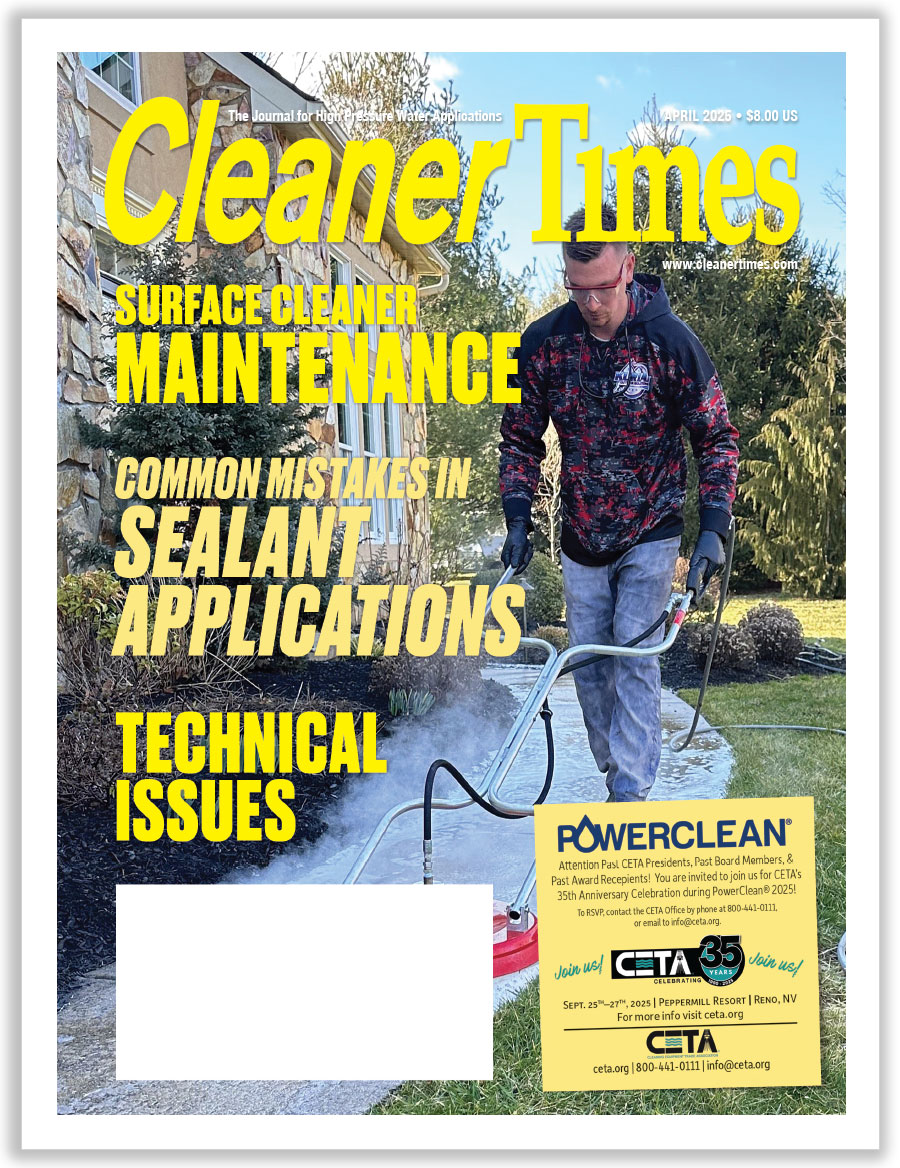
Pressure Washer’s Guidebook: Ice Dam Removal
Contributor and Photo Courtesy of Steve Kuhl, Owner, The Ice Dam Company, Hopkins, MN / Published December 2015
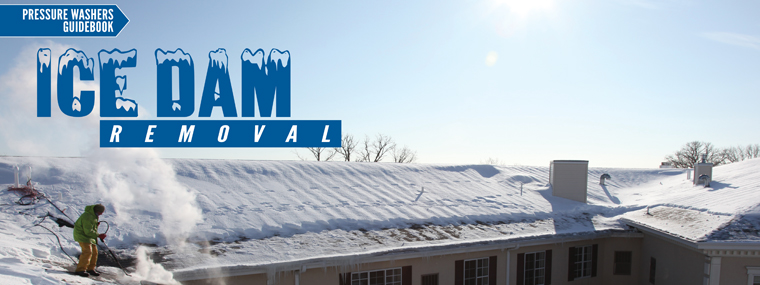
Editor’s Note: CT wants to point out at the beginning of this article that pressure washers are not to be used for ice dam removal. Instead, a true steamer must be used.
Geographical Considerations
Ice dams are most likely to occur in areas of the country that are subject to at least one or two months of cold, snowy conditions. We have found that the most favorable ice dam forming conditions appear to be when daily temperatures range from 5 F to 25 F, with the lower of that range occurring at night. Most ice dam projects are done on residential properties with the occasional commercial job mixed in.
When combined with adequate snow loads on roofs, temperatures in the range of 5 F to 25 F tend to generate more ice dams than extremes above or below that range. Dense population centers have the obvious benefit of greater economies of scale when performing any service work on homes, so it’s tougher to make a living at ice dam removal in sparsely populated areas. Cities that have a history of ice dam events include Minneapolis, Chicago, Denver, Cleve-land, Milwaukee, Detroit, and, most recently, Boston.
Typical Job
Our process for ice dam removal follows the formula for any good service company. Use the best equipment and have highly-trained personnel. Never use standard pressure washers, high-temperature pressure washers, or steam cleaners for this work—no exceptions. True steamers must be used.
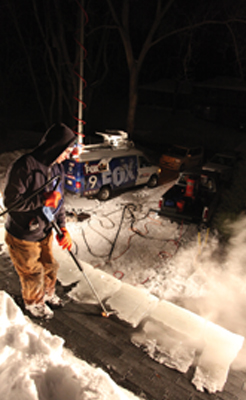
Scheduling provides a constant challenge, in particular when juggling a number of crews. We use a sophisticated GPS-based scheduling system that allows us to see where our teams are and get real-time feedback on their progress from job to job. Other administrative considerations when running an ice dam removal operation include proper insurance, good legal contracts, billing, and information management.
I own a roofing company so my roofers are the people who do this work. They are ideally suited for ice dam removal because they are comfortable on roofs. I do not recommend trying to do all of this work from a ladder. In fact, it is not possible. A professional job requires that one climb up on the roof to remove the snow prior to ice dam removal. We have developed a detailed training manual over the last 10 years, which helps us greatly reduce the possibility of personal injury and property damage, both of which are somewhat likely in the world of ice dam removal if you don’t know what you are doing.
Techniques That Work Best
Over the years, we have discovered two ways to not make money in the removal of ice dams. The first is to have machinery problems. We only get paid when we are steaming, so reliable machinery is the most important aspect of a profitable ice removal operation. The second way to lose money is to damage things while on the job. Ice chunks, if not handled properly, can smash bushes, windows, grills, tables, and other expensive things.
Here is a step-by-step process summary from job site arrival to departure:
Review the job with the client. Identify where the ice dams are and give the client a ballpark on the expected timeframe for the project.
Shovel the roof as required to expose the ice dam. We typically
shovel the entire side of a roof, not just the lower portions. This usually minimizes the likelihood of ice dams reoccurring for a couple of weeks.
Set up the equipment. A full description of how to set up and take down a commercial ice dam steamer is not possible here, so I have provided a brief overview.
• Hook up the steamer to 110v power and water. Use an interior sink, not an exterior faucet.
• Turn the water on to force the antifreeze out of the steamer and hoses. Collect and reuse the antifreeze from job to job.
• Turn the steamer on and wait five minutes for the water to reach true steam, which is around 300 F.
Begin steaming the ice dam either from a ladder or from the roof, job depending. Cut slots into the ice dam every 12 inches to 18 inches (through the ice dam, down to the roofing material). Next, undercut the ice
dam from slot to slot to free the ice from the roof. You will know it’s loose when it drops down about an inch. Finally, throw the ice chunks off the roof while watching out for all hazards below. [Where to stand: Standing directly on an ice dam is a pretty safe and stable place to be, assuming you are also under rope and harness. It’s common to see a technician standing on an ice dam and steaming it off as he works his way back toward the ladder.]
Take down the equipment and the steamer. Use the reverse process as described above to winterize the steamer for safe transport to the next
job. Never transport a steamer in open air if it is not winterized with antifreeze.
Remove any snow and ice from walkways and driveways.
Have the client sign the time sheet, approving the final job amount.
Exceptions
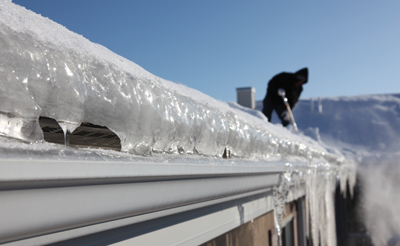
On occasion, we work on commercial properties that demand the use of more sophisticated site protection, such as scaffolding and temporary signage. We coordinate with the building manager to ensure we are in compliance with all relevant jobsite safety regulations before work begins. Because some jobs require the removal of ice from flat surfaces, such as membrane roofs, we sometimes use special water recovery pumps to evacuate the melt water generated by the steaming process from the area. This increases the job cost and complexity quite a bit.
Equipment and Supplies
We use the Arctic Steamer, sold by American Pressure out of Robbins-dale, MN (www.americanpressureinc.com). The Arctic Steamer is the only machine made specifically for ice dam removal and is well suited for the harsh conditions of sub-zero ice removal. We have tried other machines in the past with little success. Ultimately, we get paid when we are steaming ice, so reliability is the most important variable in our purchasing decisions.
There are very few supplies needed for ice dam removal other than antifreeze to protect the machinery and 1-K grade kerosene. It’s common to burn through two to three gallons of kerosene per hour per machine, so we always have plenty of extra at each job.
How To Bill
Typical ice dam removal jobs take two to four hours and are billed at $300–600 per hour depending on the particular supply and demand dynamic of the area. A proper crew should always include two people for both safety and efficiency.
We typically begin billing upon arrival onsite and stop the clock at completion of equipment takedown. Clients sign a ‘start time’ and ‘stop time’ form as a part of our on-site job contract. Consequently, we seldom have disagreements about billing. Our crews are working hard from the moment they show up to the moment they leave, an important statement of respect about the fact that this work is not cheap.
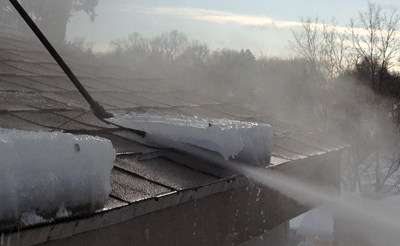
We do not provide fixed estimates for ice dam removal. Instead, we bill hourly, broken down into five minute increments. Given the relatively small size of these jobs, we cannot justify a visit from an estimator to evaluate the possible project timeframe and cost. In fact, it is impossible to estimate how long most ice dam removal projects will take, even when viewed from the ground from an experienced technician. Variables, such as roof pitch, outdoor temperatures, ice thickness and depth up on the roof, height of work, accessibility, roofing material, and other jobsite factors all play a role in how long each job will take. One of the primary factors in determining the length of a job is how far up the roof the ice has grown. This cannot be known until the roof is shoveled. Some ice dams are quite thick, as much as 14 inches or more. Those take far less time to remove than ice dams that have grown four feet up the roof slope. Another important factor noted above is outdoor temperature. Ice is much harder and takes longer to cut when temperatures dip below 10 F.
Problems to Avoid
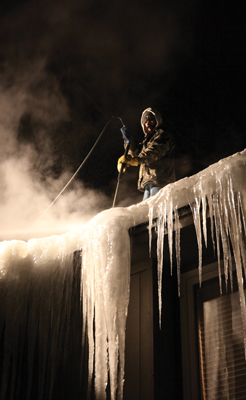
The elements of a successful ice dam removal project are as follows: no one gets hurt, nothing gets damaged, the ice dam is removed efficiently, the client is happy, and they pay their bill. It sounds simple and in many ways it is.
Work hard and as fast as you can and new client calls will follow. Always do so with sustained attention to equipment, safety, and property.
Equipment—It’s easy to have water freeze inside the steamer and hoses when working in sub-zero temperatures. The key is to use common sense. Don’t allow water to sit still in hoses for more than a few minutes without moving. Put the end of the hose into a snow bank and let it run while engaged in the machinery set up. It also pays to learn a bit about the equipment itself. We perform a lot of basic machinery maintenance onsite and in our shop instead of hauling it to our supplier. Keeping the machinery running is key to having a successful ice dam removal operation. Choose a reliable vendor and service partner for equipment.
Safety—Our guys use ropes and harnesses to stay safe. It takes a few extra minutes to set up, but, at the end of the day, it is worth it. Take time to be safe.
Property—Be very aware of what is below the work area. It is likely that if you are not conscientious, you will do damage to something, and it will cost you a lot of money. Unless you focus the steam coming out of the wand at something for an extended period of time (such as an asphalt roof), it is quite difficult to damage a home during the actual process of steaming an ice dam.
Honesty is the shortest path to success in this business. It’s true that someone can profit more by moving slowly in the process of ice dam removal. Ultimately, that will catch up with you, so I suggest focusing more on total honestly and integrity in how you approach each job.
Ancillaries
The focus should be on the job of ice dam removal for safety. Moreover, given the conditions when ice dams form, add-ons for cleaning with pressure washers are not appropriate.
(Our company does have an ancillary, which is not related directly to the pressure washer industry. We sell ice dam prevention heat cable, otherwise known as heat tape. These are heated wires that are run along the eve of the roof in a serpentine pattern. When turned on, they create pathways through any snow or ice that tries to accumulate on the roof.)
How To Fix Mistakes
Use the proper equipment to avoid mistakes. For instance, it is not professional to use a high-temperature pressure washer and call it a steamer as is sometimes done by companies that are not following correct procedures. We often lose projects to companies using such an approach, only to be called back in the summer to repair the damage they did to the roof.
Steve Kuhl has authored a number of articles on the topic of ice dams and ice dam removal. He is the founder of The Ice Dam Company (www.icedamcompany.com), the oldest and largest ice dam removal company in the country. He also owns a company (www.kuhlscontracting.com) that has provided cedar roof restoration services since 1988.

